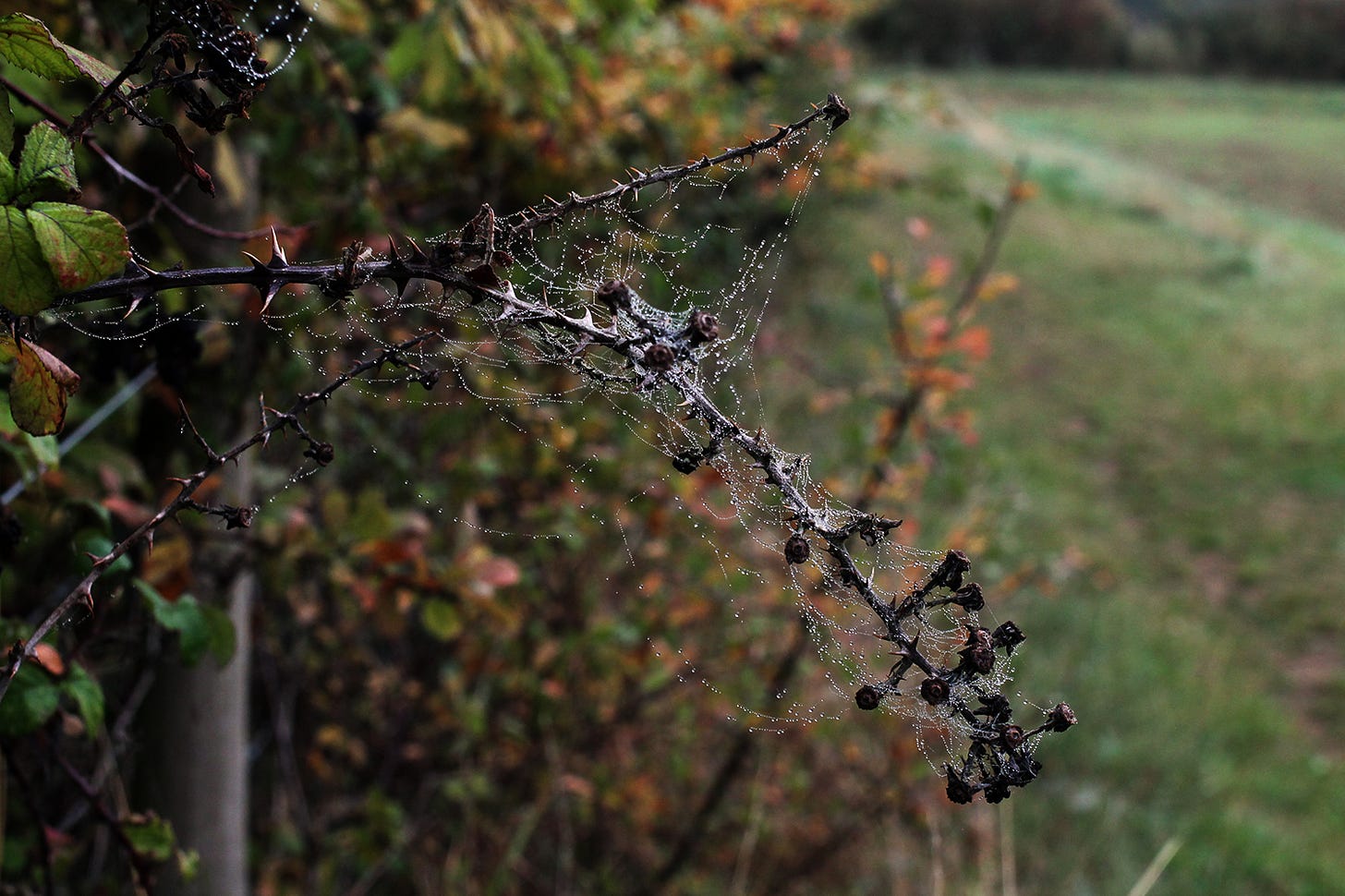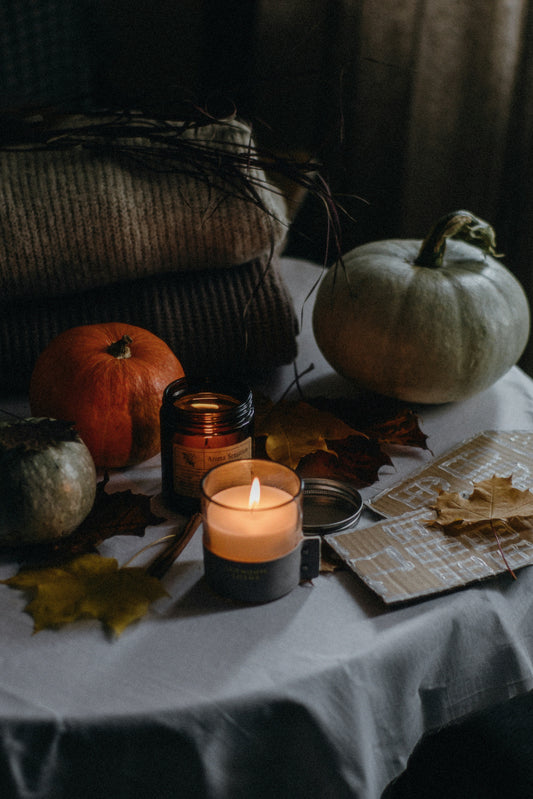At the liminal time of Samhain, as the year turns and the light fades, as we move into the darker half of the year, we’re invited to notice the extraordinary aliveness all around us
The wind of witches flew into my 10-year-old being on that wild day in the park of an old, stately home.
It felt like a remembering, a conjuring of another world shimmering behind the everydayness of school and clubs and routine. As the wind whipped around my scraggly little self, tangling my hair and flushing my cheeks, it felt wild and alive. It felt like magic.
Today is Samhain the final harvest festival in the Wheel of the Year, also known as Halloween or Hallow’s Eve. It is a time of ripe squashes and pumpkins, slow stews and root vegetables and marks both an ending and a beginning – a liminal threshold where autumn slips into winter, where we move from gathering to dreaming, from action to reflection.
Samhain has long been a time when the veil between our world and the otherworld grows thin. As my rewilding journey deepens, and the witches of my girlhood come back to life, I’ve been asking myself, what does the magic of the otherworld mean to me? Is it a place of supernatural spirits or ghostly apparitions breaking through from another realm? Was the wind of the witches I felt as a girl something beyond this earthly experience?
While I honour those who experience the magic of the otherworld as something supernatural, I’m coming to understand it as something that feels even more mysterious and awe-inspiring to me:
The “otherworld” isn’t somewhere else, it’s right here, shimmering just beneath the surface of the frantic, disconnected business of modern life. It’s the aliveness of the world itself; its animacy.
When I walk during liminal times – dawn, dusk and during Samhain – and in old, wild places I feel the land rich and heavy with aliveness, of other non-human beings going about their mysterious lives all around me. For me, the veil that thins isn’t between our world and a supernatural realm, but between my societal-driven human-centred awareness and the vast web of life in which I’m already embedded.
It was a conversation between writers David Abram and Sophie Strand, who first got me thinking of magic not as supernatural power that breaks the rules of science, but instead as “the most natural experience of a mystical order that is deeper than quantifiable rules.” Their conversation suggested that magic invites us away from a human-centric way of experiencing the world and into inter-species collaboration.
They asked: “How can we begin to understand magic as a way of becoming radically embedded in our web of relations, rather than as a way of manipulating the elements from a distance?”
I love this idea. Magic isn’t about control or supernatural intervention – it’s about intimacy. It’s about turning our loving attention to the beyond-human realms. It’s about recognising that we are already part of and in relationship with an enchanted world, if only we allowed ourselves to sink into it and notice.
Think of the spider webs that reveal themselves to us in autumn. Spiders emerge this time of year because it’s mating season, and suddenly we see their webs everywhere – especially at dawn and dusk, when they glisten with dew and catch the slanting light. They seem to appear overnight, as if by magic, these perfect geometric constructions delicately strung between tangled hedgerow branches.
And in a way, it is magic. A spider spins silk from glands on its legs, making different types of silk for different purposes – some sticky for catching prey, some strong for structural support. The web becomes an extension of the spider’s mind, a sensory organ through which it feels the vibrations of prey, mates, and danger. The spider knows the web pattern to create not through learning but through something deeper – an inherited knowledge written into its very being.
When I see a web jewelled with autumn mist, I’m not just seeing a beautiful object. I’m encountering another being’s world, another way of sensing and knowing. I’m touching the edge of the otherworld – not a realm of ghosts, but the living reality of the spider’s experience, so utterly different from my own yet intimately connected.
As I get to know the more-than-human world through my slow rewilding process, I am beginning to realise that this animacy of the world cannot be understood as personifying the other. Robert Macfarlane explains this in his book, Is a River Alive?
“A river is not a human person, nor vice versa. Each withholds from the other in different ways. To call a river alive is not to personify a river, but instead further to deepen and widen the category of ‘life,’ and in so doing—how had George Eliot put it? — ‘enlarge the imagined range for self to move in.’”
What if the wind of the witches my 10-year-old self experienced wasn’t actually witches hiding in the nearby forest but instead the felt sense of the wind’s spirit? The wind’s animacy?
What if giants and ogres aren’t large human-like creatures but a way for us to express the ancient, deep time aliveness that is stone and mountain?
What if the dragons guarding the entrances to caves is how we explain the dangerous, fiery animacy of the Earth’s depths?
What if it’s a remembering that far from being the most important beings on the planet passively observing all this life, us humans are deeply embedded in it and even help to co-create it?
Quantum physics shows the act of us observing even changes the course of an event. Physicist John Wheeler even suggested that the cosmos is ‘constantly emerging from a haze of possibility’ and that we help to create it. In the words of The Human Cosmos author Jo Marchant: “we can learn from Wheeler’s view of the universe not as pre-existing ‘out there’, but as billions upon billions of creative flashes in which we all play a vital role.”
It’s this way of seeing the aliveness of all beings around me – animals, land, wind, sky – and how deeply enmeshed we are in the web of life through time and place that is the experience of the thinning of the veil for me.
At the liminal time of Samhain, as the year turns and the light fades, as we move into the darker half of the year, we’re invited to step out of our busy, human-centered consciousness for a moment. We’re invited to notice the extraordinary aliveness around us and inside us – the fungi fruiting in the leaf litter, the ancestors written into our DNA, the birds beginning their winter migrations, the trees pulling their energy down into their roots.
The otherworld is this world, experienced with all our senses, and with humility and awe. Magic is what happens when we become radically embedded in our web of relations – when we remember that we’re not observers of nature but participants in it, when we feel the threads that connect us to the spider, the soil, the stars.
As we enter this magical season, I invite you to notice: Where do you feel the aliveness of the world? What beings are going about their mysterious lives around you? What would it mean to experience magic not as manipulation from a distance, but as intimacy with the more-than-human world?
The veil is thinning. The otherworld is here. May you feel it in your bones.






